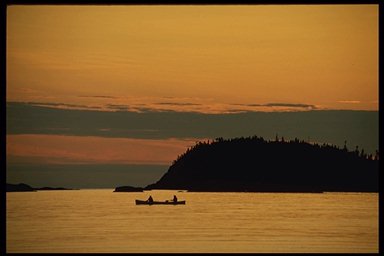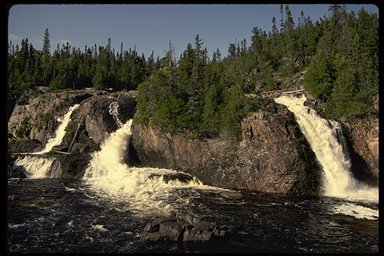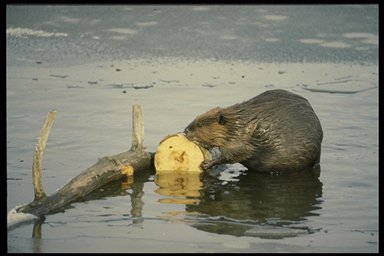Natural Region 18: Central Boreal Uplands
Represented by Pukaskwa National Park
AN INFINITY OF ROCK, WATER AND WOOD
A rugged wilderness of endless spruce forests and quaking bogs, of rock-rimmed lakes and tumbling rivers teeming with walleye, pike and trout, of moose and beaver and hordes of black flies. This region is synonymous with the Canadian Shield, the quintessential Canadian landscape. The combination of rock, water and dense forest makes this region tough country to walk in. But it is a land made for the canoe.

Oiseau Bay, Pukaskwa National Park
THE LAND:
This is a raw new land, still healing from the effects of the Ice Age. The ancient granite and gneiss of the Canadian Shield, lying exposed or covered by a thin acidic layer of grey-brown soil, give the entire region its characteristic rugged relief. The Precambrian rock is the clay from which this landscape of rough hills was formed, but it was the glaciers that gave the land its final shape. The legacy of the glaciers can be seen everywhere - in the tortuous watersheds and the myriad of lakes, ponds and bogs; in the exposed glacier-scarred bedrock; and in the moraines and drumlins hidden under the never-ending spruce forests.
One of the few anomalies in the uniformity of this region is the Athabasca Sand Dunes. These are the most extensive sand dunes in Canada. Open shifting dunes intermix with stabilized dunes, resulting in a unique landscape characterized by an unusual assemblage of plants, many of which are restricted to this site.
VEGETATION:
White spruce, black spruce, balsam fir ... white spruce, black spruce, balsam fir ... this pattern repeats itself endlessly across the region. The forest is outstanding in its uniformity. Tamarack and jack pine, along with fast-growing deciduous species such as poplar and birch, are other important members of the forest cast. Along the southern edge of the region, white pine and red pine, sugar maple, black ash, eastern white cedar and other species from the Great Lakes-St. Lawrence forest intermix in sheltered areas and depressions in which soil has accumulated. Along the northern border, the harsh climate results in an open coniferous forest with a thick mat of lichens growing between the trees.
Numberless bogs and fens support black spruce, Labrador tea, blueberries and their kin, bog rosemary, cloudberry and other acid-loving species.

Cascade River, Puskaskwa National Park
WILDLIFE:
For many, the beaver is the symbol of this area. It was the desirability of its pelt that shaped the history of this region. For others, the loon is the symbol of the boreal forest. Other typical wildlife include the moose, wolf, snowshoe hare, spruce grouse, ruffed grouse, lynx, black bear and caribou (old-growth forests providing their critical winter range). In summer, the spruce woods ring with the calls of warblers and other migratory birds.

Beaver
STATUS OF NATIONAL PARKS:
This region is represented by Pukaskwa National Park (1878 km2), a rugged wilderness of rock-rimmed lakes, tumbling rivers and dense forests, bounded by the rocky headlands and sheltered cobble and sand beaches of Lake Superior. A small herd of woodland caribou, a rare species in Canada, shares the park hinterland with moose, wolf, black bear and a host of smaller creatures. Hike the challenging Coastal Trail or paddle the shore of Lake Superior to experience Pukaskwa's wild beauty.
Pukaskwa was established in 1978 pursuant to a federal-provincial agreement with the Government of Ontario. It is not yet proclaimed under that National Parks Act because outstanding claims by local First Nations are still being negotiated.
HOME